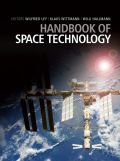
Handbook of Space Technology provides interdisciplinary coverage of all aspects of space technology. Contributions are included from more than 70 engineersand scientists who actually worked on major international space projects. It contains practical, hands-on engineering and planning information that will beinvaluable to those setting out on a career in space technology, and experienced engineers and scientists who find themselves working on space-related projects such as GIS, GPS or satellite telecommunications systems and need, or would like, a greater understanding of how these systems are actually built and placed in orbit. Coverage includes: Fundamentals (orbit mechanics, aerothermodynamics/reentry, space debris, etc.) Launch Vehicles (staged technologies, propulsion systems, launch infrastructure, etc.) Space Vehicle Subsystems (structure, energy supply, thermal controls, attitude control, communication, etc.) Aspects of Human Space Flight (man in space, life support systems, rendezvous and docking, etc.) Mission Operations (satellite operation, control center, ground station network) Utilization of Space (earth observation, communication, navigation, space astronomy, material sciences, space medicine, robotics, etc.) Configuration and Design of a Space Vehicle (mission concept, system concept, environmental simulation, system design, Galileo satellites, etc.) Management of Space Missions (project management, quality management, cost management, space law, etc.) Unlike an encyclopedia, it carefully considers space systems and their operation not just topics in isolation. On the other hand, it is put together in such a manner that the reader can dip into it and extract valuable information without having to read entire chapters. In short, it is the ideal handbook for space engineering.
- ISBN: 978-0-470-69739-9
- Editorial: John Wiley & Sons
- Encuadernacion: Cartoné
- Páginas: 908
- Fecha Publicación: 14/04/2009
- Nº Volúmenes: 1
- Idioma: Inglés
